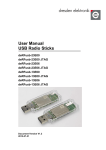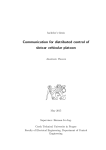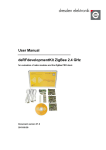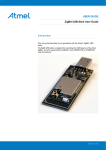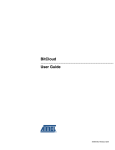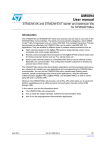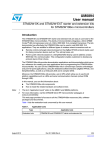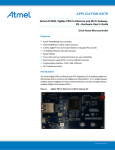Download dresden elektronik deRFusb-13E06 Programming instructions
Transcript
APPLICATION NOTE Atmel AT02597: ZigBee PRO Packet Analysis with Sniffer Atmel MCU Wireless Features • ZigBee® Protocol Analysis with Industry-standard sniffing tools such as Luxoft’s BitCatcher, Wireshark and Perytons • Provides instructions and examples on using the sniffer to analyze and debug network behavior Description Monitoring Wireless network activity in ZigBee networks is essential in understanding the behavior and traffic patterns of the network. Network Protocol analyzers are powerful and flexible tools that aid debugging during ZigBee-based application development. This Application Note describes how to configure and use supported sniffing tools along with Atmel® MCU-based sniffer hardware platforms. 32210A−WIRELESS−09/2013 Table of Contents 1. Overview .............................................................................................. 3 1.1 The Wireshark Capture Interface from Atmel Gallery........................................ 3 1.1.1 Setup Information ............................................................................... 4 1.2 BitCatcher ......................................................................................................... 5 1.2.1 Setup Information ............................................................................... 5 1.3 Perytons Network Analyser ............................................................................... 6 2. Sniffer Capture Session Setup ............................................................. 7 2.1 Wireshark Capture Interface ............................................................................. 7 2.2 BitCatcher ......................................................................................................... 8 2.3 Perytons Network Analyser ............................................................................. 10 3. Configuring Sniffer Preferences ......................................................... 12 3.1 Wireshark Capture Interface ........................................................................... 12 3.2 BitCatcher ....................................................................................................... 14 3.3 Perytons Network Analyzer ............................................................................. 15 4. Analyzing Data Traffic in ZigBee PRO Networks ............................... 17 4.1 ZigBee Frame Format Overview ..................................................................... 17 4.2 MAC Association ............................................................................................. 17 4.3 Network Rejoin with and without PDS ............................................................. 20 4.4 Self-Leave and Parent-Induced Leave ............................................................ 22 4.5 Network Link Status Frame ............................................................................. 23 4.6 Multicast .......................................................................................................... 24 4.7 Fragmentation ................................................................................................. 25 4.8 Service Discovery ........................................................................................... 26 4.9 Tunneling in Secure Networks ........................................................................ 26 5. Analyzing Data Traffic in ZigBee PRO Public Profile Networks ......... 28 5.1 ZigBee Home Automation ............................................................................... 28 5.1.1 Service Discovery ............................................................................. 28 5.1.2 Attribute Reporting ............................................................................ 28 5.1.3 Commands ....................................................................................... 29 5.1.4 Security ….. ...................................................................................... 29 5.2 ZigBee Light Link ............................................................................................ 29 5.2.1 Touchlinking ...................................................................................... 29 5.2.2 Cluster Commands ........................................................................... 30 5.2.3 Security ….. ...................................................................................... 30 5.3 ZigBee Smart Energy ...................................................................................... 30 6. Example Application Scenarios.......................................................... 31 6.1 PAN Same Channel Co-Existence .................................................................. 31 6.2 End-to-End Establishment of Application Link Key ......................................... 31 6.3 ZLL – ZHA Interoperability .............................................................................. 32 7. References ......................................................................................... 33 8. Revision History ................................................................................. 34 Atmel AT02597: ZigBee PRO Packet Analysis with Sniffer [APPLICATION NOTE] 32210A−WIRELESS−09/2013 2 1. Overview In ZigBee networking, a sniffing tool is important during development and testing for the capture and analysis of frames exchanged in the network. It is more significant in networks that have ZigBee products from different vendors to test and verify that they inter-operate with one another. The sniffing tool shall be capable of real-time capture of frame formats supported by the ZigBee protocol and the IEEE® 802.15.4 standard. The sniffer shall also provide parsed information of different fields and sub-fields of the frame, which shall aid the user in quick analysis. A visual view of the network topology, time stamping, multi-channel capture and saving of the capture files are some of the features of sniffers that the user can benefit from, to gain a complete picture of the wireless environment that is being monitored. The Wireless network sniffer environment is setup by running one of the network protocol analyzers in Figure 1-1 on the PC. Figure 1-1. Supported ZigBee Network Protocol Analyzers. To start capturing frames on an IEEE 802.15.4 channel, one should have a sniffer hardware tool running a sniffer firmware, plugged into the PC. Figure 1-2. Supported Sniffer Hardware Platforms. The RZUSBSTICK and the deRFusb23E06 [10] can be used to sniff IEEE 802.15.4 2.4GHz operating channels. The deRFusb13E06 [10] can be used as an IEEE 802.15.4 sub-GHz sniffer. 1.1 The Wireshark Capture Interface from Atmel Gallery A simple Capture Interface that can be used to create capture sessions for IEEE 802.15.4 2.4GHz channels is available for download from Atmel Gallery. Apart from the RZUSBSTICK, this interface supports the RZ600-RF231 radio board [2] as a sniffer hardware platform. Atmel AT02597: ZigBee PRO Packet Analysis with Sniffer [APPLICATION NOTE] 32210A−WIRELESS−09/2013 3 1.1.1 Setup Information To setup the capture session using Wireshark, download the Atmel Wireshark Interface from Atmel Gallery [7]. Wireshark version Wireshark-win32-1.8.0 or lesser shall be installed on the PC [8]. Figure 1-3. Atmel Wireshark Interface in Atmel Gallery. • The package is installed in directory \Atmel\AtmelWiresharkFirmware • Follow the instructions in the Readme_Important_Atmel_Wireshark_Sniffer_Interface.txt to complete the setup procedure • The sniffer firmware to be flashed on the respective hardware platforms, RZUSBSTICK and RZ600 are provided as images (Wireshark_Sniffer_Raven.hex and Wireshark_Sniffer_RZ600.elf) in the package • Refer to [4] and [2] for programming instructions Caution: For the RZUSBTICK, the fuse settings shall be: Extended: 0xFB, High: 0x91, Low: 0xDE • • This version of the Wireshark capture interface (v1.0) does not support sub-GHz sniffer tools The USB drivers available with the package support Windows® XP/2000/7 and are automatically loaded to Windows by the installer. Chapter 2 provides further information on setting up a capture session for the Wireshark Interface. Atmel AT02597: ZigBee PRO Packet Analysis with Sniffer [APPLICATION NOTE] 32210A−WIRELESS−09/2013 4 1.2 BitCatcher Luxoft BitCatcher ZigBee Network Analyze tool is a simple and flexible protocol analyzer that can be used to analyze standard IEEE 802.15.4 and ZigBee frames using Atmel hardware sniffing tools in the sub-GHz and 2.4GHz frequency bands. 1.2.1 Setup Information The sniffer PC tool can be downloaded from [3]. The package also comes with the firmware files and drivers for the supported sniffer hardware: • • Atmel AVR® RZUSBSTICK Dresden Elektronik deRFusb-23E00 (2.4GHz) and deRFusb-13E00 (Sub-GHz) Once installed, sniffer device can be configured for use with the sniffer PC tool as below. • • Plug in the sniffer hardware (e.g.: RZUSBSTICK) to a free USB port in the PC Flash the sniffer firmware image to the MCU on the sniffer hardware, if not pre-programmed Caution: For the RZUSBTICK, the fuse settings shall be: Extended: 0xFB, High: 0x91, Low: 0xDE • The firmware images for the RZUSBSTICK and the deRFUSB is available as .hex files in the directory \embedded inside the BitCatcher package • Un-plug and plug the device into the USB port once again. Install the driver provided in the sniffer package when prompted for • • The sniffer drivers are available in the directory \driver inside the BitCatcher package After driver installation, the device will be listed in the Windows Device Manager as shown in Figure 1-4 Figure 1-4. Sniffer Devices Listing in Windows Device Manager. Atmel AT02597: ZigBee PRO Packet Analysis with Sniffer [APPLICATION NOTE] 32210A−WIRELESS−09/2013 5 1.3 Perytons Network Analyzer The Perytons Analyzer is a powerful sniffing tool with support for Atmel sniffer hardware platforms for both 2.4GHz and sub-GHz IEEE 802.15.4 bands. This application note gives only a brief overview of its features and analysis of data captures with the Perytons Network Analyzer. Further information can be found at [9]. Atmel AT02597: ZigBee PRO Packet Analysis with Sniffer [APPLICATION NOTE] 32210A−WIRELESS−09/2013 6 2. Sniffer Capture Session Setup This chapter shows the user how to setup a sniffer capture session after the installation of the hardware driver and the sniffer tool in the PC has been done successfully. 2.1 Wireshark Capture Interface • Open Wireshark_Sniffer_Interface.exe from \Program Files\Atmel\AtmelWiresharkFirmware • From the Sniffer Port column, select the Sniffer port number and click Open as shown in Figure 2-1 Figure 2-1. COM Port Selection. • As the Sniffer Capture interface supports 2.4GHz channels, the user can select a channel from Channel 11 to Channel 26 • After the channel is set, click Start to begin the capture session as shown in Figure 2-2. A Wireshark instance will be invoked automatically Atmel AT02597: ZigBee PRO Packet Analysis with Sniffer [APPLICATION NOTE] 32210A−WIRELESS−09/2013 7 Figure 2-2. Starting a Sniffer Capture Session. • 2.2 After the capture session is complete, the user can save the capture file for further analysis BitCatcher • Open BitCatcher and add a new sniffer device as shown in Figure 2-3 with the port settings in Figure 2-4 Figure 2-3. Adding a New Sniffer Device. • It is possible to edit or remove the connection using the same menu Atmel AT02597: ZigBee PRO Packet Analysis with Sniffer [APPLICATION NOTE] 32210A−WIRELESS−09/2013 8 Figure 2-4. Port Settings. • Once the device is created, it will appear in the device drop-down menu in BitCatcher and shall be selected as shown below. After device selection, the connect/Disconnect button shall be pressed to begin or end the usage of the sniffer hardware with BitCatcher Figure 2-5. Device Selection. • After the device connection with BitCatcher is established, the user can configure the Channel and Channel pages supported. Standard IEEE 802.15.4 channels are supported in the 2.4GHz, 868 and 915MHz frequency bands • Supported Channels in the 2.4GHz bands are from Channel 11 to channel 26 as per formula, Fc = 2405 + 5 (k - 11) in [MHz], for k = 11, 12... 26 where k is the channel number. • Channel 0 is for 868MHz operation and Channels 1 to 10 for 915MHz band. IEEE 802.15.4 -2006 specified channel pages 0, 2 and 5 are supported • The Data capture session can be started or stopped using the Play Button in BitCatcher Atmel AT02597: ZigBee PRO Packet Analysis with Sniffer [APPLICATION NOTE] 32210A−WIRELESS−09/2013 9 Figure 2-6. Starting the Data Capture Session. • BitCatcher allows users to save the sniffer capture data in the form of .dcf files and it is also possible to open sniffer logs created using other sniffing tools, if the logs are in the .dcf format File->Open log/Save log options serve these purposes. 2.3 Perytons Network Analyzer The Data capture session in Perytons Network Analyzer can be started using the Data Capture button as shown in Figure 2-7. Figure 2-7. Starting the Data Capture Session. Before capture is started, it shall be ensured that the hardware is detected by the sniffer tool and the settings are as per Figure 2-8. Atmel AT02597: ZigBee PRO Packet Analysis with Sniffer [APPLICATION NOTE] 32210A−WIRELESS−09/2013 10 Figure 2-8. Configuring the Capture Parameters. The user can save the capture file using the Save & Continue option shown in Figure 2-8. Atmel AT02597: ZigBee PRO Packet Analysis with Sniffer [APPLICATION NOTE] 32210A−WIRELESS−09/2013 11 3. Configuring Sniffer Preferences For easier viewing and analysis, sniffers GUIs provide multiple filtering options. With the appropriate settings, a complete snapshot of the wireless network can be obtained. This chapter provides information on configuring such preferences in the sniffer GUI. 3.1 Wireshark Capture Interface • Protocols: Wireshark automatically identifies the protocol in use, as all supported protocols are enabled by default, as can be seen in menu option Analyze -> Enabled Protocols. The user can enable or disable protocols as per requirement using this option • Security: It is possible to monitor encrypted ZigBee network data by entering the NWK security key used in the network. Use menu option Edit -> Preferences -> Protocols -> ZigBee NWK as shown in Figure 3-1 Figure 3-1. Security Preferences in Wireshark The security level shall be set as per the ZigBee specification, Table 3-1 is taken from the ZigBee specification document and lists the supported security levels. Atmel AT02597: ZigBee PRO Packet Analysis with Sniffer [APPLICATION NOTE] 32210A−WIRELESS−09/2013 12 Table 3-1. Security Levels – NWK and APS – ZigBee Specification. Security level identifier Security level subfield (Table 4.24) Security attributes Data encryption Frame integrity (length M of MIC, in number of octets) 0x00 ‘000’ None OFF NO (M = 0) 0x01 ‘001’ MIC-32 OFF YES (M = 4) 0x02 ‘010’ MIC-64 OFF YES = (M = 8) 0x03 ‘011’ MIC-128 OFF YES (M = 16) 0x04 ‘100’ ENC ON NO (M = 0) 0x05 ‘101’ ENC-MIC-32 ON YES (M = 4) 0x06 ‘110’ ENC-MIC-64 ON YES = (M = 8) 0x07 ‘111’ ENC-MIC-128 ON YES (M = 16) It is possible to add multiple keys, edit or remove existing keys as shown in Figure 3-2. Example: In a ZigBee network using security in the APS layer, a device joining the network establishes a link key with the Trust Center. In order to view all APS transactions for this link such as the APS Transport Key command, the Trust Center link key needs to be added to the sniffer preferences. Figure 3-2. Security Key Entries. • User Interface Options: It is possible to customize viewing options in the Wireshark interface • Arrange the layout of the panels from Edit -> Preferences -> Layout • Add Columns to the packet display pane (e.g.: HW src addr) from Edit -> Preferences -> Columns • Colorize frame formats (e.g.: NWK Link Status Frames) from View -> Coloring Rules • Apply Filters to display frames based on chosen fields in a frame by right-clicking on the field and using option Apply as Filter Atmel AT02597: ZigBee PRO Packet Analysis with Sniffer [APPLICATION NOTE] 32210A−WIRELESS−09/2013 13 Figure 3-3. Wireshark Capture Screen Layout. 3.2 BitCatcher • Protocols: By default, BitCatcher is automatically able to parse the following protocol packets: • IEEE 802.15.4 MAC • ZigBee PRO (Network, ZDO and APS layers) • ZigBee Public Profiles such as ZigBee Smart Energy, Home Automation, and Light Link It is not possible to explicitly disable any of the above protocols in BitCatcher, although it is possible to enable or disable packet views of various ZigBee PRO layers (NWK, APS and ZCL). This configuration can be done using menu option Window -> Sniffer -> Preferences ->Layers • Security: It is possible to monitor encrypted ZigBee network data by entering the NWK security key used in the network. Use menu option Window -> Sniffer -> Preferences -> Core security as shown in Figure 3-4 Figure 3-4. Security Preferences in BitCatcher. Atmel AT02597: ZigBee PRO Packet Analysis with Sniffer [APPLICATION NOTE] 32210A−WIRELESS−09/2013 14 The security level shall be set as per the ZigBee specification, Table 3-1 is taken from the ZigBee specification document and lists the supported security levels. ZigBee Light Link (ZLL) security keys used for inter-PAN data exchange can also be configured in this sniffer using menu option Window -> Sniffer -> Preferences -> ZLL security. It is possible to add multiple keys, edit or remove existing keys as shown in Figure 3-4. If the key is not added to sniffer, the packets shall not be decrypted and shall be displayed in a turquoise blue color font. • 3.3 User Interface Options: It is possible to customize viewing options in BitCatcher • The default layout of the sniffer provides a snapshot of the packet log, a timeline view as well as a packet dissector called the Packet view. It is possible to drag and re-arrange the views as per need and also close views • The menu option Window -> Show view can be used to show a view closed by the user • Add Columns to the packets log panel (e.g.: HW src addr) by right-clicking on any column in the panel and selecting the option Manage Columns • Packets are colorized depending on the layer at which they are formed and sent out (NWK, APS, and MAC). Apply Filters to display frames based on chosen fields in a frame by using menu option Window -> Preferences -> Filters Perytons Network Analyzer • Protocols: Perytons supports the following protocols: • IEEE 802.15.4 MAC • ZigBee PRO (Network, ZDO and APS layers) • ZigBee Public Profiles such as ZigBee Smart Energy, Home Automation, and Light Link The active protocol can be set when the capture session is configured as shown in Figure 2-8. • Security: It is possible to monitor encrypted ZigBee network data by entering the NWK security key used in the network. Use menu option Window -> Sniffer -> Preferences -> Core security as shown in Figure 3-5 Figure 3-5. Security Preferences in Perytons. Atmel AT02597: ZigBee PRO Packet Analysis with Sniffer [APPLICATION NOTE] 32210A−WIRELESS−09/2013 15 The security level shall be set as per the ZigBee specification, Table 3-1 is taken from the ZigBee specification document and lists the supported security levels. • User Interface Options: It is possible to customize viewing options in Perytons • The tool provides different viewing options such as the Time view, Network view, Message view, Statistics, and Message Tree view. The user can enable or disable views using menu option Windows • Add Columns to the packets log panel (e.g.: HW src addr) by right-clicking on any column in the panel and selecting the option Manage Columns • Packets are colorized as per settings in Tools -> Preferences • Apply Filters to display frames based on chosen fields in a frame by using menu option Window -> Preferences -> Filters Figure 3-6. Perytons Example Capture Window. Atmel AT02597: ZigBee PRO Packet Analysis with Sniffer [APPLICATION NOTE] 32210A−WIRELESS−09/2013 16 4. Analyzing Data Traffic in ZigBee PRO Networks This chapter provides examples of common interaction in ZigBee PRO networks that shall aid the user to look closely into various fields of the frame and is not aimed at covering all scenarios that fall under ZigBee specification. Explaining the meaning of all the fields used in a ZigBee frame is outside the scope of this application note and shall be looked up in the ZigBee specification [6]. All Configuration Server (CS) parameters mentioned in this Application Note can be set from application configuration.h or at run-time using CS_WriteParameter API. The description of the CS parameters is also present in respective API_Reference.chm available in the \Documentation folder in the BitCloud® SDK. Information on when the parameter shall be set (at compile time only, at run-time before network start or at any time) along with parameter persistence is available in this file. 4.1 ZigBee Frame Format Overview Figure 4-1 shows the skeletal overview of the ZigBee frame format. Figure 4-1. Frame Format. The APS and NWK layer security headers and footers are also shown in the Figure 4-1. ZigBee uses a non-beacon enabled MAC format with no security in the MAC layer. 4.2 MAC Association Every node in a ZigBee network has its own unique 64-bit IEEE/MAC address. When a node joins the network for the first time, a MAC association procedure is performed, following which it obtains a 16-bit network (short) address from the parent. This short address is used for further communication in the network, to reduce frame overhead. BitCloud provides a configuration parameter in application called CS_UID which can be used to set the value of the 64bit MAC address of the node during compilation. The following conditions prevail: • Setting CS_UID for testing: Any random 64-bit value can be set at compile time in application configuration.h or at run-time before calling ZDO_StartNetworkReq() • Setting CS_UID during production: Commercial usage of ZigBee products require purchase of a block of IEEE/MAC addresses from IEEE. This can be programmed into an external EEPROM specifically used for this purpose. In this case, CS_UID can be set to zero during compile-time, BitCloud will attempt to read the value from the external EEPROM in this case using API, HAL_ReadUid() Atmel AT02597: ZigBee PRO Packet Analysis with Sniffer [APPLICATION NOTE] 32210A−WIRELESS−09/2013 17 When a node starts up, it does network discovery by performing an active scan over the channels specified in the CS_CHANNEL_MASK parameter in BitCloud. A beacon request is sent as seen in packet #4 in Figure 4-2. Upon reception of a beacon request frame, routers and coordinators already present in network automatically respond with a beacon frame. The joining node filters a potential parent based on the settings in the beacon packet received. Figure 4-2. Node Joins Network Via MAC Association Using IEEE Address 0x55ULL. The beacon from the coordinator/router contains the Association Permit subfield, it is set to TRUE if the device is accepting association to the PAN. A joining node cannot associate to the device if this sub-field is FALSE. CS_PERMIT_DURATION controls the joining of devices into the network by setting the permit duration. Figure 4-3. assocPermit Sub-Field in the Beacon Frame. Example: Figure 4-4 shows parsed beacon payload that contains information based on which the joining node chooses a potential parent. The beacon payload provides information on the ZigBee stack profile used in the network (ZigBee PRO = 0x02), network protocol version (nwkcProtocolVersion, 0x02 as per ZigBee PRO specification). The router capacity, enddevice capacity and device depth limits the acceptance of children by a parent node. Atmel AT02597: ZigBee PRO Packet Analysis with Sniffer [APPLICATION NOTE] 32210A−WIRELESS−09/2013 18 Figure 4-4. Beacon Payload. Table 4-1. Config. Server Parameters Affecting Beacon Payload. Capability info sub-field Config. server parameter routerCapacity CS_MAX_CHILDREN_ROUTER_AMOUNT edCapacity CS_MAX_CHILDREN_AMOUNT A joining device indicates its capability information in the MAC association request it sends to its potential parent as shown in Figure 4-5 and Table 4-2. Figure 4-5. Capability Information in a MAC Association Request. Table 4-2. Config. Server Parameters Affecting Capability Info. Capability info sub-field Config. server parameter deviceType CS_DEVICE_TYPE rxOnWhenIdle CS_RX_ON_WHEN_IDLE Atmel AT02597: ZigBee PRO Packet Analysis with Sniffer [APPLICATION NOTE] 32210A−WIRELESS−09/2013 19 Without a proper setting of the CS_UID parameter, a node tries to repeatedly join the network CS_ZDO_JOIN_ATTEMPTS times unsuccessfully. Figure 4-6. Node Tries to Join Network Without Proper Setting of IEEE Address. 4.3 Network Rejoin with and without PDS There are multiple join options that can be configured using BitCloud as mentioned in [1]. Network rejoin method is used when a node wishes to join a network with knowledge of networking parameters such as the network’s extended PANID or application-assigned short address, operating channel or others. Figure 4-7 shows examples of several successful network rejoin procedures. Atmel AT02597: ZigBee PRO Packet Analysis with Sniffer [APPLICATION NOTE] 32210A−WIRELESS−09/2013 20 Figure 4-7. Node Joins Network Via Rejoin Procedure with PDS Not Used in Application. The Persist Data Server (PDS) Component provides useful API to store networking parameters to persistent memory to retain them over device resets. See section PDS in [1]. With PDS APIs used in application, the node сan be configured to come back into the network without performing over-the-air rejoin procedure. In Figure 4-8, the node with short address 0x0001 joins network via rejoin from packet #3. Just before packet #13, this node is reset and it is seen that the device does not do further rejoin to come into the network. The node reset behavior and further restoration of configuration server parameters with PDS can be verified by looking at the values of the sequence numbers and counter values in various layers. These parameters are among the config. server parameters and hence are restored on rejoin with PDS implemented. Without PDS implementation, the stack resets these values to default values on startup. Atmel AT02597: ZigBee PRO Packet Analysis with Sniffer [APPLICATION NOTE] 32210A−WIRELESS−09/2013 21 Figure 4-8. Node Joins Network Via Rejoin Procedure with PDS Used in Application. The silent rejoin is very useful when nodes are reset after a battery change, or after a mains-powered network has reset after a power outage. The nodes come back into the network seamlessly and can route packets, with their networking tables restored from Persistent memory to RAM. Packet #9 shows a device announcement frame. This broadcast frame is sent by a device after it has properly authenticated into the network. Devices that receive this frame update their network address map tables with the device information obtained in the device annce frame. 4.4 Self-Leave and Parent-Induced Leave ZDP Requests are managed by the ZDO layer and can be used for various network control scenarios as detailed in [1]. Network leave can be processed using ZDP requests when a device needs to leave the network on certain events. Network leave can be self-induced on a node or a node can order another remote node to leave the network. Atmel AT02597: ZigBee PRO Packet Analysis with Sniffer [APPLICATION NOTE] 32210A−WIRELESS−09/2013 22 Figure 4-9. Self-Leave of Node With Short Address 0x0001 and Extended Address 0x02ULL. Figure 4-10. Parent Node 0x0000 Sends a ZDP Request Requesting Child 0x0001 to Leave. It is possible to configure options such as rejoin, removal of children in the leave request. 4.5 Network Link Status Frame NWK link status frames are sent by routers and coordinator so that neighboring nodes can maintain information on the link costs required for routing. Link Status frames are periodically transmitted as one-hop broadcasts. The Link Status list contains the short address and link cost information of all neighboring nodes as shown in Figure 4-12. Atmel AT02597: ZigBee PRO Packet Analysis with Sniffer [APPLICATION NOTE] 32210A−WIRELESS−09/2013 23 Figure 4-11. Header Information in a NWK Link Status Frame. Table 4-3. 4.6 Config. Server Parameters Relevant to NWK Link Status. Information Config. server parameter Neighbor Table size CS_NEIB_TABLE_SIZE Number of missed link status frames to remove an entry from neighbor table CS_NWK_MAX_LINK_STATUS_FAILURES Multicast Broadcasting a message to a group of nodes involves creating a group table entry for a specified end-point and group ID. Refer to Section 6.4.3 Multicast transmission in [1] for implementation specifics. Sniffer log, multicast.dcf, shows a multicast transmission from coordinator to Group 1 and end-point 0xF0 in #34.The network destination address is the group address. Multicasts do not have APS Acknowledgements and are re-broadcast by all routers (group members and nonmembers) until the radius is exhausted. Figure 4-13 shows the non-member radius which is decremented on every nonmember re-broadcast of the frame. Atmel AT02597: ZigBee PRO Packet Analysis with Sniffer [APPLICATION NOTE] 32210A−WIRELESS−09/2013 24 Figure 4-12. Multicast Sub-Field – NWK Header. In response to #34, group member node 0x31BC responds with APL data on end-point 0xF0 whereas node 0x0BDD is a non-member and so does not respond. 0x0BDD is then added to the group and so responds with APL data on end-point 0xF0 in #59. 4.7 Fragmentation When APL data packets greater than the maximum size of the APL payload needs to be sent, the stack fragments the entire data into blocks. The fragmentation concept is explained in Section 6.7 Fragmentation of [1]. Figure 4-13. Fragmentation – Relevant Header Information. Atmel AT02597: ZigBee PRO Packet Analysis with Sniffer [APPLICATION NOTE] 32210A−WIRELESS−09/2013 25 Figure 4-14. Fragmentation – Example. As per ZigBee specification, the first fragment is sent with the block number as the total number of blocks comprising the entire APL data, as seen in Figure 4-14. The subsequent fragments have block numbers starting from 1 onwards up to maximum transmission window size. The receiving node sends an APS Acknowledgment frame when all blocks in the transmission window have been received. Table 4-4. 4.8 Config. Server Parameters Affecting Data Transmission. Information Config. server parameter Single Fragment size CS_APS_BLOCK_SIZE Number of fragments /blocks the APL data is split into CS_APS_MAX_BLOCKS_AMOUNT Number of blocks to be sent before expecting an APS ACK CS_APS_MAX_TRANSMISSION_WINDOW_SIZE Size of a single fragment in fragmented transmission CS_APS_TX_BLOCK_SIZE Size of one receive buffer that will hold one fragment of the data frame. CS_APS_RX_BLOCK_SIZE Service Discovery Service Discovery is the process of collecting information on supported clusters on other devices in the network. Service discovery uses ZDP requests (with MATCH_DESCRIPTOR_CLID) for every cluster ID supported. Service discovery requests can be unicast or broadcast and so the response contains the network address of the responder along with the matched simple descriptor information. The response contains a match list with the end-points that support the cluster in the request. Service discovery is explained in further detail in Section 5.1.1. 4.9 Tunneling in Secure Networks Consider a network wherein a node insecurely joins through a router parent (i.e.) the joining node does not know the network key prior to join procedure. In this case, the APS command used to securely communicate the network key from the Trust Center to the newly joined router is called the APS Tunnel command. Referring to sniffer log, Transport_key_tunnel.dcf, end-device 0x01LL joins router 0x0000000100000000 from packet #26. The parent router sends an APS Update Device command to the Trust Center to inform the Trust Center that a node has joined or left the network. Figure 4-11 shows the update status of the device, depending on which the Trust Center takes necessary action (i.e.) to send the network or remove the key and associated security counters for the device. Atmel AT02597: ZigBee PRO Packet Analysis with Sniffer [APPLICATION NOTE] 32210A−WIRELESS−09/2013 26 Figure 4-15. Status Field in APS Update Device Command. Trust Center sends the APS Tunnel command frame in #39. The Tunnel command frame will contain the secured frame to be sent to the destination, in its payload. #43 shows the APS Transport Key command frame sent from the router parent to the newly joined end-device. It includes the key sequence number and the active network key. In case the router has joined with a pre-configured network key, the APS Transport packet would contain key sequence number and the key values as all-zeros. End-device receives the Transport Key command frame, sets and activates the network key and does a device announcement to the network. Atmel AT02597: ZigBee PRO Packet Analysis with Sniffer [APPLICATION NOTE] 32210A−WIRELESS−09/2013 27 5. Analyzing Data Traffic in ZigBee PRO Public Profile Networks Networks based on ZigBee PRO Public Profiles such as ZigBee Smart Energy, Home Automation, Light Link employ specific join, security and data exchange schemes. The implementation details of the reference applications can be found in [5]. This chapter provides sniffer data analysis of example sniffer logs taken using [5]. The sniffer logs are provided in a zip package with this application note and this chapter references packet numbers from these logs. The logs are in *.dcf format and can be viewed in BitCatcher. 5.1 ZigBee Home Automation The Home Automation (HA) reference application in BitCloud Profile Suite implements six HA device types. The sniffer log, HA_TC_DL_DS.dcf, demonstrates data exchange between a Trust Center, Dimmable Light and Dimmer switch device. 5.1.1 Service Discovery The Dimmable Light device joins the network created by the Trust Center from packet #3 and the Dimmer switch from #17. This network employs standard network security with application link keys. #32 shows a Match Descriptor Request broadcast by the dimmer switch to all devices with macRxOnWhenIdle = TRUE (nwkHeader->dstShortAddr = 0xFFFD). The Match Descriptor Data field consists of the number of clusters and the cluster ID .The request should be issued individually for each server and client cluster. Hence, in #37, the in/client cluster count is 0x01 and cluster ID is the ONOFF_CLUSTER_ID.In #178, the in cluster count is 0x00, the out/server cluster count is 0x01 and the cluster ID is the ONOFF_SWITCH_CONFIGURATION_CLUSTER_ID. The profile ID is PROFILE_ID_HOME_AUTOMATION defined in zcl.h and the cluster related defines in clusters.h found in \ZCL\include directory in the BitCloud SDK. The Trust Center does not support the clusters in this request and so simply re-broadcasts the packet (#33 shows this, the apsHeader->counter and nwkHeader sequence number stay same, whereas the nwkHeader->radius is decremented by one on re-broadcast). The Match descriptor response gives sufficient information about the responder (short address, endpoint and cluster information) for the requester device to do a device discovery (IEEE address determination) and binding. Every cluster binding creates an entry in the requester’s binding table. Table 5-1. 5.1.2 Relevant Config. Server Parameters. Network information Config. server parameter Binding Table CS_APS_BINDING_TABLE_SIZE IEEE and short Address pair CS_ADDRESS_MAP_TABLE_SIZE Attribute Reporting The HA reference application sets up automatic reporting of attributes with application configured report period. In #113, dimmable light reports value of attribute ID, ZCL_ONOFF_CLUSTER_ONOFF_SERVER_ATTRIBUTE_ID (attributeStatusList) of the ONOFF_CLUSTER_ID (apsHeader -> clusterId). The ZCL header specifies that the direction of this frame (server to client) and this being a common ZCL specified frame, the manufSpec is set to zero. Atmel AT02597: ZigBee PRO Packet Analysis with Sniffer [APPLICATION NOTE] 32210A−WIRELESS−09/2013 28 This sub-field shall be set to TRUE for all manufacturer-specific extensions to ZCL specification (addition of new attributes, commands to existing clusters and addition of new clusters). 5.1.3 Commands The HA reference application demonstrates usage of ZCL specified commands. In #189, an addGroup command is sent from the Dimmer switch to the Light for the Group ID, defined in the application. On receiving this command, the dimmable Light adds the Group ID and Group Name to its Group Table (maintained by the application). It shall then generate an appropriate Add Group Response command indicating success or failure. It is useful to group devices to send messages to the group as broadcast data. In #333, an On command is sent from the Dimmer switch to the Light with the noDefaultResp sub-field in the ZCL header set to zero. This causes a default Response packet to be sent out from the light with the statusCode 0x00(SUCCESS). Default Response is sent out under the following conditions: 1. 2. 3. 5.1.4 The Disable default response bit of its Frame control field is set to 0(as discussed above). No response command exists for the received command. For an unsupported command received. Security By default, network layer encryption with the network key is used for cluster commands. Table 5-2. Relevant Config. Server Parameters. Config. server parameter 5.2 Knowledge of security keys on device CS_ZDO_SECURITY_STATUS Active Network Key CS_NETWORK_KEY ZigBee Light Link The ZLL Demo in the BitCloud Profile Suite for ZLL package implements standard device types: color scene controller, color light and bridge. The sniffer log referenced in this section is ZLL_CL_CSR.wrk which shall be viewed with Perytons Network Analyzer. 5.2.1 Touchlinking The ZigBee Light Link network is not created by a coordinator. Instead, network parameters are transferred from an innetwork device to a factory-new device (device that is to join the network). This process of transferring network information occurs as Inter-PAN data exchange and is called touchlinking or commissioning. In the sniffer log, packets #3 to #20 cover the touch-link procedure. All frames in this sequence follow the inter-PAN command format specified by [6]. Table 5-3. Fields of Interest – Inter-PAN Command Frame Format. Frame field Value MAC header -> Frame Control panIDComp or Intra-PAN set to zero NWK/APS header-> Frame Control Frame Type set to reserved type Inter-PAN Transaction Identifier 32-bit unique value valid throughout Touchlink process Atmel AT02597: ZigBee PRO Packet Analysis with Sniffer [APPLICATION NOTE] 32210A−WIRELESS−09/2013 29 The first part of the Touchlink process is the scanning done on the channel set (primary and if required, secondary) to search for devices in the vicinity. To monitor activity on multiple channels at the same time, it is necessary that the sniffing tool is capable of multichannel capture and the number of hardware sniffing tools used shall equal the number of channels to be monitored. The log, ZLL_CL_CSR.wrk, was captured using a Perytons M-series Network Analyzer. It is also possible to use BitCatcher and Wireshare interface and start capture on the first primary channel (0x0B) and identify the logicalChannel selected from the network start response frame payload. 5.2.2 Cluster Commands The command and response frame transfer is as explained in Section 5.1.3. 5.2.3 Security A ZLL network uses network layer security. Cluster data exchange can define security level in the cluster definition file. A non-ZLL device when being commissioned into the ZLL network gets the network key securely using a pre-installed link key. The ZLL pre-installed link key is a secret shared by all certified ZLL devices and will be distributed only to certified manufacturers. For development and testing purposes, the ZLL specification allows use of the keys in Table 5-4.These values can be found in file N_Security_Calc.c in directory \zllplatform\zll\n_security\src in the BitCloud for ZLL SDK package. Table 5-4. 5.3 Security Keys. Key Value Certification Network Key ZLL_SECURITY_KEY "\xC0\xC1\xC2\xC3\xC4\xC5\xC6\xC7\xC8\xC9\xCA\xCB\xCC\xCD\xCE\xCF" Certification pre-installed Link key ZLL_PREINSTALLED_LINK_KEY "\xD0\xD1\xD2\xD3\xD4\xD5\xD6\xD7\xD8\xD9\xDA\xDB\xDC\xDD\xDE\xDF" ZigBee Smart Energy ZigBee Smart Energy networks employ similar data exchange mechanisms using clusters and commands as described in Section 5.1. Smart Energy Profile Security is different from the standard network security with link keys employed in Home Automation networks. Smart Energy security requires the use of the Key Establishment cluster to generate a link key for secure data exchange between two devices in a SE network. The sniffer log, SE_Key_estb.dcf, shows the packet exchange during the key establishment process which is called the Certificate Based Key Establishment (CBKE) process. #17 shows that the device with short address 0x4810 has joined the network and authenticated to the Trust Center 0x0000 successfully using a pre-configured Trust Center Link key. After service discovery for the KE cluster, #36 shows the transfer of the Initiate Key Establishment frame from 0x4810 to 0x000 and the response frame from the Trust Center. These frames contain the following items: • Timing information of generation of the remaining KE packets. This is configurable as the cryptographic computation time may vary with devices • Identity field containing the test Certificate of the device Packets #55 and #64 show exchange of Ephemeral data which contains a randomly generated public key. #73 and #83 show exchange of the Confirm Key request and response frames, these messages contain the derived /generated link key which will be used for further communication between the two devices. Atmel AT02597: ZigBee PRO Packet Analysis with Sniffer [APPLICATION NOTE] 32210A−WIRELESS−09/2013 30 6. Example Application Scenarios The zip package that comes with this application note includes sniffer logs with the example application scenarios below. This will help the user to understand the packet exchange in the following cases that are not directly covered by the reference applications in the BitCloud SDK. These scenarios require the user to modify the application to see and understand the described scenarios. 6.1 PAN Same Channel Co-Existence It is possible to have multiple ZigBee networks on the same channel. The sniffer log, pan_same_channel_coexistence.dcf, shows that it is possible for a second PAN to be started in the presence of an existing PAN. Packet #0 to 426 shows data transfer in a Personal Area Network (PAN) with the short PANID 0x1AAB as can be seen from the macHeader->dstPanID field. This PAN consists of three devices, a coordinator, a router (macHeader>srcShortAddr =0x912F) and an end-device (macHeader->srcShortAddr =0x0B27). The end-device transfers data to the router every two seconds. Packet #427 shows the MAC beacon request from another coordinator device to which the coordinator and router from the PAN 0x1AAB respond with beacons. The Beacon payload shows an extPanId of 0xBB BB BB BB BB BB BB BB BB BB BB BB BB BB BB. The second coordinator starts a network with extPanId of 0xAA AA AA AA AA AA AA AA AA AA AA AA AA AA AA AA and short PANID 0x1AAAA. #432 shows the MAC beacon request from an end-device to which the coordinator of 0x1AAA, coordinator and router of 0x1AAB respond. The end-device joins network with PANID 0x1AAB at its coordinator, as its information base contains the extended PANID 0xAA AA AA AA AA AA AA AA AA AA AA AA AA AA AA AA. Further, a router joins network 0x1AAB and the end-device transfers data to this router every two seconds. 6.2 End-to-End Establishment of Application Link Key In a secure network, when two devices need to communicate on a secure link with each other, they shall request a link key from the Trust Center. In Figure 6-1, Router 0xEA1E requests for a link key to Trust Center to communicate with router 0x12DC. Atmel AT02597: ZigBee PRO Packet Analysis with Sniffer [APPLICATION NOTE] 32210A−WIRELESS−09/2013 31 Figure 6-1. Link Key Establishment Between Two Routers Trust Center uses the Transport Key command to send the link key to both the routers. The link key is applied in further data exchange between the routers. #3678 uses this link, as seen in the packet view -> apsMic-> Key. 6.3 ZLL – ZHA Interoperability It is possible for a ZigBee Home Automation device to join a ZLL network. The sniffer log, ZLL_HA_S_L_GW.dcf, shows an occupancy sensor device joining a ZLL network at packet #305. It does a classical join and service discovery for the occupancy sensing cluster ID,0x0406.The Profile ID can be observed to be 0x0104(Home Automation Profile). The occupancy sensor then periodically reports the value of the occupancy sensing attribute to the ZLL light. Atmel AT02597: ZigBee PRO Packet Analysis with Sniffer [APPLICATION NOTE] 32210A−WIRELESS−09/2013 32 7. References [1]. Atmel AVR2050: BitCloud Developer Guide [2]. RZ600 [3]. BitCatcher [4]. AVR2015: RZRAVEN Quick Start Guide [5]. BitCloud Profile Suite [6]. ZigBee Standards Documentation [7]. Atmel Wireshark Interface - Atmel Gallery [8]. Wireshark [9]. Perytons Network Analyzer [10]. Dresden Elektronik Sniffer Tools Atmel AT02597: ZigBee PRO Packet Analysis with Sniffer [APPLICATION NOTE] 32210A−WIRELESS−09/2013 33 8. Revision History Doc. Rev. Date Comments 32210A 09/2013 Initial document release Atmel AT02597: ZigBee PRO Packet Analysis with Sniffer [APPLICATION NOTE] 32210A−WIRELESS−09/2013 34 Atmel Corporation Atmel Asia Limited Atmel Munich GmbH Atmel Japan G.K. 1600 Technology Drive Unit 01-5 & 16, 19F Business Campus 16F Shin-Osaki Kangyo Building San Jose, CA 95110 BEA Tower, Millennium City 5 Parkring 4 1-6-4 Osaki, Shinagawa-ku USA 418 Kwun Tong Road D-85748 Garching b. Munich Tokyo 141-0032 Tel: (+1)(408) 441-0311 Kwun Tong, Kowloon GERMANY JAPAN Fax: (+1)(408) 487-2600 HONG KONG Tel: (+49) 89-31970-0 Tel: (+81)(3) 6417-0300 www.atmel.com Tel: (+852) 2245-6100 Fax: (+49) 89-3194621 Fax: (+81)(3) 6417-0370 Fax: (+852) 2722-1369 © 2013 Atmel Corporation. All rights reserved. / Rev.: 32210A−WIRELESS−09/2013 Atmel®, Atmel logo and combinations thereof, AVR®, BitCloud®, Enabling Unlimited Possibilities®, and others are registered trademarks or trademarks of Atmel Corporation or its subsidiaries. Windows® is a registered trademark of Microsoft Corporation in U.S. and or other countries. Other terms and product names may be trademarks of others. Disclaimer: The information in this document is provided in connection with Atmel products. No license, express or implied, by estoppel or otherwise, to any intellectual property right is granted by this document or in connection with the sale of Atmel products. EXCEPT AS SET FORTH IN THE ATMEL TERMS AND CONDITIONS OF SALES LOCATED ON THE ATMEL WEBSITE, ATMEL ASSUMES NO LIABILITY WHATSOEVER AND DISCLAIMS ANY EXPRESS, IMPLIED OR STATUTORY WARRANTY RELATING TO ITS PRODUCTS INCLUDING, BUT NOT LIMITED TO, THE IMPLIED WARRANTY OF MERCHANTABILITY, FITNESS FOR A PARTICULAR PURPOSE, OR NON-INFRINGEMENT. IN NO EVENT SHALL ATMEL BE LIABLE FOR ANY DIRECT, INDIRECT, CONSEQUENTIAL, PUNITIVE, SPECIAL OR INCIDENTAL DAMAGES (INCLUDING, WITHOUT LIMITATION, DAMAGES FOR LOSS AND PROFITS, BUSINESS INTERRUPTION, OR LOSS OF INFORMATION) ARISING OUT OF THE USE OR INABILITY TO USE THIS DOCUMENT, EVEN IF ATMEL HAS BEEN ADVISED OF THE POSSIBILITY OF SUCH DAMAGES. Atmel makes no representations or warranties with respect to the accuracy or completeness of the contents of this document and reserves the right to make changes to specifications and products descriptions at any time without notice. Atmel does not make any commitment to update the information contained herein. Unless specifically provided otherwise, Atmel products are not suitable for, and shall not be used in, automotive applications. Atmel products are not intended, authorized, or warranted for use as components in applications intended to support or sustain life.




































